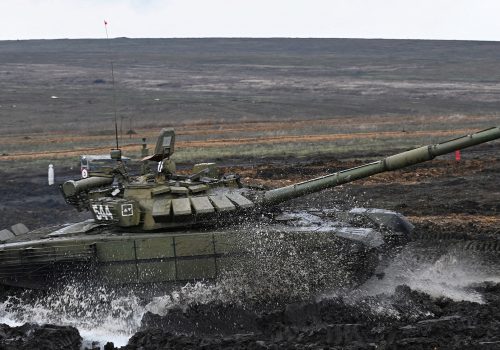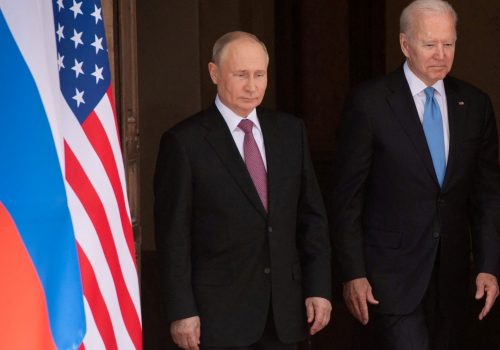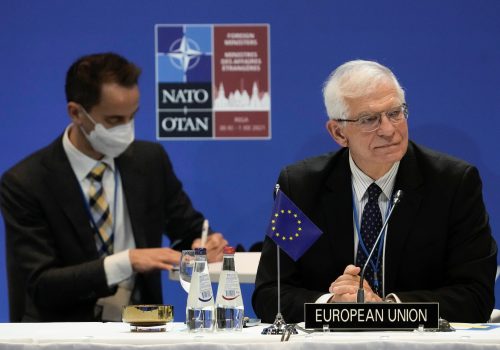FAST THINKING: The US bets big on NATO to deter Russia
GET UP TO SPEED
The cavalry is coming! Maybe. The US Department of Defense announced Monday that it has put 8,500 forces on “heightened alert” to deploy to Eastern Europe as a means of countering Russia’s threatened invasion of Ukraine. But what really has heads turning is that the United States plans to dispatch some of the troops as part of a rarely used NATO Response Force (NRF). Can the United States convince the twenty-nine other NATO members to support the troop movement? What signal does this send to Moscow at this perilous moment? Our NATOlogists are on the case.
TODAY’S EXPERT REACTION COURTESY OF
- Chris Skaluba: Director of the Scowcroft Center’s Transatlantic Security Initiative and former principal director for European & NATO policy at the US Defense Department
- Leah Scheunemann: Deputy director of the Transatlantic Security Initiative and former Pentagon official
A MESSAGE TO MOSCOW—AND BRUSSELS
- The primary audience for this action resides in the Kremlin. “After months of watching Russian forces move into position along Ukraine’s borders, US forces are starting to make reciprocal moves,” Chris says. It amounts to “a concession” that the Biden administration’s diplomacy to avert a Russian invasion “needs some military muscle behind it to have any chance of succeeding.”
- The shift comes as the United States touts its shipments of more weapons and military aid to Ukraine and stages a long-planned military exercise in the Mediterranean Sea. While welcome, these deterrence measures have not come fast enough and so far proved insufficient, Leah argues. “As of now, the US has only ordered its people out of Ukraine,” she points out, referring to the US government’s evacuation of diplomats’ families from Kyiv.
- Monday’s announcement also sends “a signal to NATO allies to get with the program,” Chris adds. While “NATO has been united politically” during the crisis with Russia, he notes, “there has been more divergence operationally on when and how to reinforce [its] frontline allies.”
WHAT’S THE NRF, ANYWAY?
- Originally conceived in 2002, the NRF is a quick-response multinational force of 40,000 troops that has been used only sparingly over the past two decades for missions like disaster relief. Chris likens it to “an expensive sports car that is never allowed to leave the garage but for a slow drive around the block.”
- When Russia annexed Crimea in 2014, the force sat on the sidelines, “a classic NATO non-action,” Chris tells us. At one point, Atlantic Council senior fellow John Deni even argued for disbanding the NRF altogether in favor of something more useful in a crisis.
- Now the United States has put the keys in the sports car’s ignition. But all thirty allies must now agree to take it for a spin. Leah worries that requirement for consensus could be a convenient excuse for inaction. “It will be disappointing,” she says, if the Biden administration waits on NATO approval for the NRF rather than acting on its own or with smaller groups of allies.
- Leah says those options include “bolstering US forces where NATO already has its enhanced Forward Presence battlegroups in Poland, Lithuania, Latvia, and Estonia,” sending rotational forces to Bulgaria and Romania, or boosting naval operations in the Baltic and Black seas.
WHAT TO WATCH NEXT
- To be proactive ahead of any invasion, the United States should work with European nations bilaterally to send more forces to NATO’s eastern flank, Leah argues, as “part of a larger diplomatic effort to get Russia onto an offramp at a time when it is really difficult to see how Putin does not invade.”
- After the Pentagon’s announcement, US President Joe Biden held a call with the heads of NATO, the European Union, the United Kingdom, Germany, France, Poland, and Italy. Leah is watching what those allies say and do now, particularly after the French readout of the call didn’t mention NATO—much less the NRF—among France’s plans. “The more public the West is in its deliberations, the more obvious fractures in NATO’s cohesion will be,” she says.
- Chris calls the NRF strategy a “risky gambit” that could flop if it fails to deploy in the event that Russia attacks Ukraine, falling short of expectations and exposing more disharmony among NATO allies. Nevertheless, he adds, “give credit to the administration for a creative approach that introduces a new dimension to the deterrence puzzle—one that is more of a tangible threat of escalation than escalation itself.”
Further reading
Thu, Jan 20, 2022
Will Russia make a military move against Ukraine? Follow these clues.
Experts react By
Our military fellows from the US Army, Navy, Air Force, and Marine Corps give a sense of the movements from Russia that they're tracking most closely.
Fri, Jan 21, 2022
SpeedRead: The military steps Biden can take to force Putin to back off
New Atlanticist By Jorge Benitez
The White House should deal with the Kremlin-manufactured crisis with the bipartisan strategy that successfully won the Cold War: deterrence.
Sat, Jan 22, 2022
Experts react: Six options for Europe as it searches for a response to Russian aggression
New Atlanticist By
How can Europe hang together and maximize its impact? Our experts weigh in as the crisis over Ukraine heats up.
Image: German and Romanian soldiers stand on the tarmac of a NATO airport in Constanta, Romania, on July 1, 2021. Photo via Christophe Gateau/dpa.


